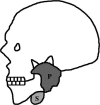Assessment of post-radiotherapy salivary glands
- PMID: 21511748
- PMCID: PMC3473647
- DOI: 10.1259/bjr/66754762
Assessment of post-radiotherapy salivary glands
Abstract
Salivary glands are usually irradiated during radiotherapy for head and neck cancers, which can lead to radiation-induced damage. Radiation-induced xerostomia (oral dryness) is the most common post-radiotherapy complication for head and neck cancer patients and can reduce the patient's quality of life. Accurate and efficient salivary gland assessment methods provide a better understanding of the cause and degree of xerostomia, and may help in patient management. At present, there are different methods for the assessment of salivary gland hypofunction; however, none of them are considered to be standard procedure. This article reviews the value of common methods in the assessment of post-radiotherapy salivary glands.
Figures






Comment in
-
Post-radiogenic density changes on CT of the salivary gland are time-dependent.Br J Radiol. 2011 Dec;84(1008):1156; author reply 1157. doi: 10.1259/bjr/50052857. Br J Radiol. 2011. PMID: 22101584 Free PMC article. No abstract available.
References
-
- Astreinidou E, Roesink JM, Raaijmakers CPJ, Bartels LW, Witkamp TD, Lagendijk JJ, et al. 3D MR sialography as a tool to investigate radiation-induced xerostomia: feasibility study. Int J Radiat Oncol Biol Phys 2007;68:1310–19 - PubMed
-
- Marmiroli L, Salvi G, Caiazza A, Di Rienzo L, Massaccesi M, Murino P, et al. Dose and volume impact on radiation-induced xerostomia. Rays 2005;30:145–8 - PubMed
-
- Nishimura Y, Nakamatsu K, Shibata T, Kanamori S, Koike R, Okumura M, et al. Importance of the initial volume of parotid glands in xerostomia for patients with head and neck cancers treated with IMRT. Jpn J Clin Oncol 2005;35:375–9 - PubMed
-
- Eisbruch A, Ship JA, Dawson LA, Kim HM, Bradford CR, Terrell JE, et al. Salivary gland sparing and improved target irradiation by conformal and intensity modulated irradiation of head and neck cancer. World J Surg 2003;27:832–7 - PubMed
-
- Coppes RP, Vissink A, Konings AWT. Comparison of radiosensitivity of rat parotid and submandibular glands after different radiation schedules. Radiother Oncol 2002;63:321–8 - PubMed
Publication types
MeSH terms
LinkOut - more resources
Full Text Sources
Medical

